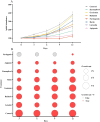Application of flavonoid compounds suppresses the cotton aphid, Aphis gossypii
- PMID: 40247935
- PMCID: PMC12003358
- DOI: 10.3389/fpls.2025.1545499
Application of flavonoid compounds suppresses the cotton aphid, Aphis gossypii
Abstract
Introduction: The cotton aphid Aphis gossypii is a significant polyphagous crop pest and has evolved a high level of resistance to neonicotinoids and other insecticides. Flavonoids, plant phytonutrients, have shown promise as natural insect deterrents and growth inhibitors. However, comprehensive evaluations of the effects of flavonoids on A. gossypii are currently lacking.
Methods: In this study, we first evaluated the effects of seven flavonoids (kaempferol, genistein, daidzein, naringenin, rutin, luteolin, and apigenin) on aphid settling behavior using choice assays, followed by electrical penetration graph (EPG) recordings to assess their influence on feeding activity. We then measured honeydew excretion and conducted life table analysis under laboratory conditions to assess effects on growth and reproduction. Under greenhouse conditions, all seven flavonoids were tested for their inhibitory effects on A. gossypii population growth over 12 days. Based on the results, three effective flavonoids were selected for further testing at four concentrations (1×, 2×, 3×, and 4× of 1 μg/μL) to assess dose-dependent effects.
Results: We found that all seven flavonoids significantly deterred aphid settling on host plants. Kaempferol, daidzein, naringenin, rutin, luteolin, and apigenin significantly reduced the total duration of phloem feeding and the proportion of time spent on phloem-related activities. And also, each of seven flavonoids reduced honeydew production compared to controls. In the laboratory, all flavonoids reduced adult longevity and fecundity, and kaempferol, genistein, daidzein, naringenin, luteolin and apigenin also reduced the net reproductive rate (R0), intrinsic rate of increase (rm), and finite rate of increase (λ). Naringenin, apigenin, and kaempferol significantly inhibited A. gossypii population growth in a dose-dependent manner over 12 days.
Discussion: These results demonstrate that the seven flavonoids, especially naringenin, apigenin, and kaempferol tested provided effective management of A. gossypii populations by deterring host settling, reducing phloem feeding, honeydew production, and decreasing reproductive rates. This study highlights the potential of flavonoids as eco-friendly control agents against A. gossypii.
Keywords: Aphis gossypii; antifeedant activity; ecofriendly pest control; fecundity; flavonoids; population Growth.
Copyright © 2025 Zhang, Wang, Bian, Se, Yang and Lu.
Conflict of interest statement
The authors declare that the research was conducted in the absence of any commercial or financial relationships that could be construed as a potential conflict of interest.
Figures



Similar articles
-
Effects of Seven Plant Essential Oils on the Growth, Development and Feeding Behavior of the Wingless Aphis gossypii Glover.Plants (Basel). 2024 Mar 22;13(7):916. doi: 10.3390/plants13070916. Plants (Basel). 2024. PMID: 38611446 Free PMC article.
-
Volatiles from essential oils of three Lamiaceae plants repel the winged cotton aphid, disturb its feeding behavior and reduce its fecundity.Pest Manag Sci. 2024 Sep;80(9):4253-4263. doi: 10.1002/ps.8130. Epub 2024 Apr 26. Pest Manag Sci. 2024. PMID: 38624184
-
Effects of dimpropyridaz on feeding behavior, locomotivity and biological parameters of Aphis gossypii.Pestic Biochem Physiol. 2023 Dec;197:105694. doi: 10.1016/j.pestbp.2023.105694. Epub 2023 Nov 13. Pestic Biochem Physiol. 2023. PMID: 38072549
-
Impact of Temperature on Survival Rate, Fecundity, and Feeding Behavior of Two Aphids, Aphis gossypii and Acyrthosiphon gossypii, When Reared on Cotton.Insects. 2021 Jun 21;12(6):565. doi: 10.3390/insects12060565. Insects. 2021. PMID: 34205528 Free PMC article.
-
Unlocking the Potential: How Flavonoids Affect Angiogenesis, Oxidative Stress, Inflammation, Proliferation, Invasion, and Alter Receptor Interactions in Endometriosis.Food Sci Nutr. 2024 Dec 7;13(1):e4607. doi: 10.1002/fsn3.4607. eCollection 2025 Jan. Food Sci Nutr. 2024. PMID: 39803270 Free PMC article. Review.
References
-
- Ateyyat M., Abu-Romman S., Abu-Darwish M., Ghabeish I. (2012). Impact of flavonoids against woolly apple aphid, Eriosoma lanigerum (Hausmann) and its sole parasitoid, Aphelinus Mali (Hald.). J. Agric. Sci. 4, 227. doi: 10.5539/jas.v4n2p227 - DOI
-
- Bindhu V. R., Ganga S., Dayanandan S. (2016). Impact of partially purified compounds of Boerhavia diffusa on Callosobruchus chinensis L. (Coleoptera: Chrysomelidae: BruChinae). J. Entomol. Res. 40, 11–15. doi: 10.5958/0974-4576.2016.00002.5 - DOI
LinkOut - more resources
Full Text Sources

